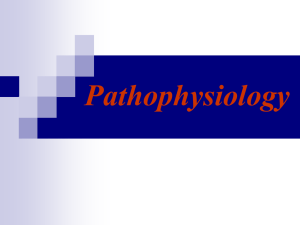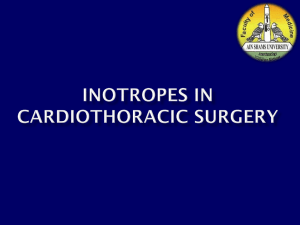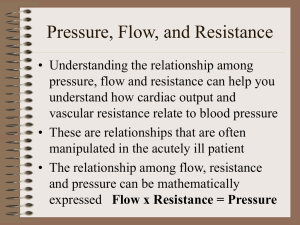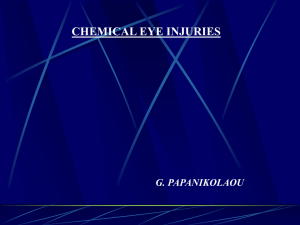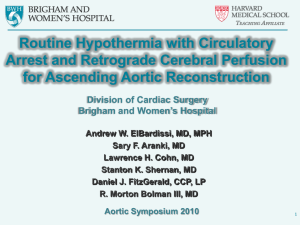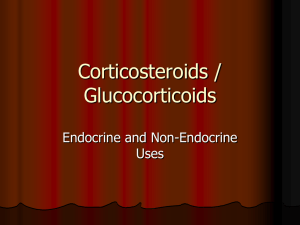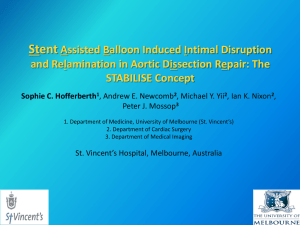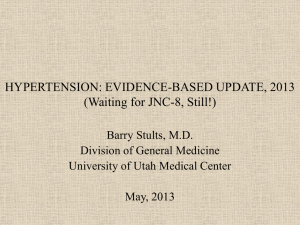Anesthesia for Valvular Heart Surgery
advertisement
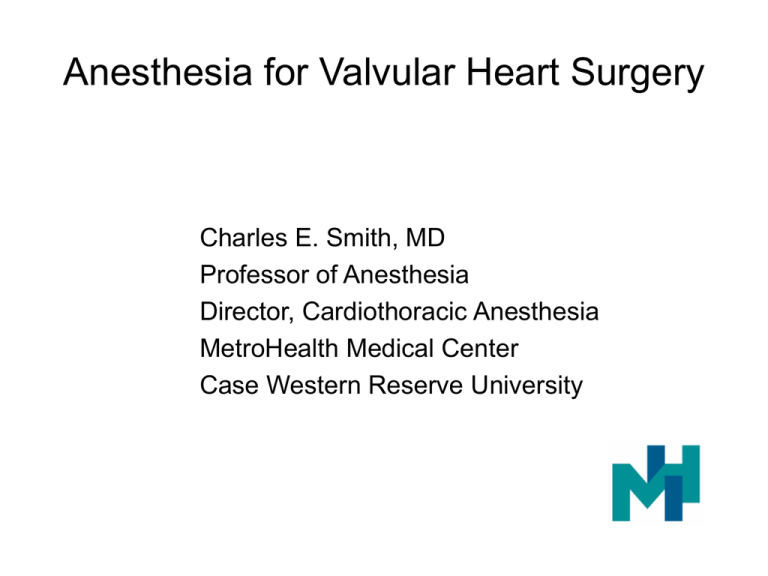
Anesthesia for Valvular Heart Surgery Charles E. Smith, MD Professor of Anesthesia Director, Cardiothoracic Anesthesia MetroHealth Medical Center Case Western Reserve University Objectives • Pathophysiology – Aortic valve: AS, AI – Mitral valve: MS, MR – Tricuspid valve: TR • Hemodynamic Goals • Anesthetic management Aortic Stenosis • May occur at 3 levels: 1. Valvular 2. Subvalvular 3. Supravalvular Valvular Aortic Stenosis 1. Calcification + fibrosis of normal tricuspid valve- very common 2. Calcification + fibrosis of congenital bicuspid AV 3. Rheumatic- uncommon since antibiotics Aortic Stenosis • • • • Normal AVA: 2-4 cm2 Severe AS: AVA < 1cm2 If normal LV- mean PG > 50 mmHg If poor LV function- mean PG may be low! Pathophysiology of Aortic Stenosis • Chronic LV pressure overload • Concentric LVH to ↓ wall stress • LVH → ↓ diastolic compliance, ↓ coronary blood flow + imbalance of MVO2 supplydemand • ↓ diastolic compliance → ↑LVEDP + LVEDV • Myocardial ischemia bc LVH, ↑ wall stress, ↓ diastolic coronary perfusion + ↓ coronary flow reserve Hemodynamic Goals: AS • SR is crucial. Cardiovert SVTs promptly • Optimal HR 60-80. Tachycardia → ischemia + ectopy. Bradycardia → low CO due to fixed SV • Adequate preload essential but difficult to predict bc diastolic dysfunction [TEE useful] • Maintain contractility. Avoid myocardial depressants • Treat hypotension promptly- phenylephrine, volume, Trendelenburg AS: Considerations • Drugs to maintain CPP: – Phenylephrine – Norepinephrine • Atrial kick – crucial. HR 60-80 preferred • Spinal + epidural anesthesia poorly tolerated if preload or HR AS: Management • Premed: young+ anxious get benzos. Frail + elderly dose (or avoid) • Intraop: std monitoring + preinduction art line. • Resting HR 60-80. Avoid myocardial depressants • CVP, PAC, TEE- routine for optimal management AS: Weaning from Bypass • Thick, hypertrophied heart may be difficult to protect- stone heart still occurs (rare) • Noncompliant LV dependent on stable rhythm • Inotropes if preop LV dysfunction • Dynamic subaortic or cavitary obstruction after AVR if septal LVH • Tx w volume, β-blockers. Rarely need myomectomy [inotropes worsen obstruction] Septal LVH with SAM. Tx= volume + beta-blockers Aortic Regurgitation: Etiology 1. Aortic root dilatation- HTN, ascending aorta dissection, cystic medial necrosis, Marfans, syphilitic aortitis, ankylosing spondylitis, osteogenesis imperfecta 2. Deformed + thickened cusps- rheumatic, IE, bicuspid valve 3. Cusp prolapse- dissection Horse kick to upper chest with severe AI. The RCC was torn from the STJ Pathophysiology: Chronic AR • Asymptomatic for many years • LV volume + pressure overload occurs • LV maintains systolic fct by dilation + ↑ compliance • LV decompensates at later stages w ↑ LVEDP + LVEDV→ CHF, arrhythmias, sudden death Pathophysiology: Acute AR • LV unable to dilate acutely • LV volume overload occurs • ↑ LVEDP + LVEDV→ acute pulmonary edema • Emergency surgery often needed Hemodynamic Goals: AR • • • • • Optimal HR= 90. Avoid bradycardia- ↑ regurg Avoid high afterload SNP preferred Acute AR- often need inotropes + vasodilator [epi+ SNP/milrinone] • IABP- contraindicated Anesthetic Management: AR • • • • • Premed w benzos Routine monitoring: art line, CVP, PAC TEE beneficial Narcotic based technique if impaired LV If acute AR: RSI w ketaminesuccinylcholine • Inotropes if acute AR or preop LV dysfunction Mitral Stenosis • Usually rheumatic- thickening, calcification + fusion of MV leaflets + commissures • May be combined w MR + AR • Surgery if MVA < 1 cm2 w NYHA class III or IV dyspnea [or embolus- LAA clot] MS- Pathophysiology • Pressure gradient between LA + LVprevents LV filling • Pulmonary HTN w ↑ LAP • ↑ LAP → LAE, atrial arrhythmias (Afib) • Pulm HTN → RV dysfct, RVE, TR [may need TV repair] • LV dysfct uncommon unless CAD MS: Hemodynamic Goals • Preserve SR, if present • Avoid tachycardia which ↓ diastolic filling of LV + worsens MS • Avoid factors which worsen pulmonary HTN- hypercarbia, acidosis, hypothermia, sympathetic nervous system activation, hypoxia Anesthetic Management: MS • Premed: benzos to avoid tachycardia • If pulm HTN- supplemental O2 • Control of HR- β blockers, digoxin, CEB, amiodarone Intraop Management: MS • Std monitors + CVP, PAC, TEE • PAP underestimates LVEDP + LVEDV • Esmolol: – single most useful drug with severe MS, even if CHF + pulmonary edema – 10-20 mg bolus; 50-100 mcg/kg/min • N2O avoided bc effects on pulm HTN • Panc avoided bc tachycardia Weaning from Bypass: MS • MV replacement- hemodynamics usually improved bc obstruction to LV filling resolved • If preop pulm HTN + RV dysfctmay need milrinone or nitric oxide Mitral Regurgitation: Etiology 1. Myxomatous degeneration (most common) 2. Ischemic (functional)- papillary muscle dysfunction, annular dilatation, LV dysfct + tethering 3. Infective endocarditis 4. Trauma Papillary muscle rupture after blunt trauma MR- Pathophysiology • • • • Volume overload of LV→ LVE, LAE LA can massively dilate Atrial arrhythmias with LAE Dilated LV decompensates at later stages w LVEDV Chronic MR. Dilated LA w normal LAP Chronic MR. Dilated LA w normal LAP Acute MR. Small LA with ↑ ↑ LAP+ pulmonary edema Severity of MR 1. Pressure gradient between LA + LV 2. Size of regurgitant orifice (ERO) 3. Duration of ventricular systole Hemodynamic Goals- MR: • Vasodilators: NTG, SNP - ↓ afterload + regurgitant fraction + ↑ forward flow • High normal HR to ↑ time of ventricular systole • Maintain contractility Anesthetic Management MR: • MV repair (v. replacement) – preserved papillary muscle + chordae – enhanced LV function – requires TEE to assess repair • LV dysfct unmasked after MV surgery bc LV cannot offload into LA • May need inotropes + vasodilators Tricuspid Regurgitation • Primary: rheumatic, IE, carcinoid, Ebstein’s, trauma • Secondary: chronic RV dilatation, often w MV disease Flail TV after blunt trauma TR- Pathophysiology • RV + RA overloaded + dilated • RA v compliant so RAP rises only w end stage disease • Pulm HTN due to MV disease↑ RV afterload + worsens TR • RVE → paradoxical motion LV septum w imapired LV filling + compliance • Right heart failure: hepatomegaly, ascites TR- Hemodynamic Goals • If secondary to MV- treat left heart lesion • Avoid pulm HTN + high PVR • Normal to high preload for RV stroke volume • Hypotension treated w inotropes + volume bc vasoconstrictors may worsen pulm HTN TR- Anesthetic Management • Premed- benzos • Std monitors + art line, CVP, TEE • PAC if pulm HTN + MV pathology; but CO overestimated w severe TR. May be impossible to float Swan • Weaning from CPB: if preop RV dysfunction/ dilation- inotropes, inodilators, vasodilators, nitric oxide Summary- I • Knowledge of patient + extent of valvular heart disease • Functional + hemodynamic status • Co-morbidities • Planned surgery: cannulation sites, repair vs replacement, minimally invasive vs full bypass. • Inotropes, vasodilators, vasopressors, infusion pumps Summary- II • Understand pathophysiology of lesions + hemodynamic goals: AS, AR, MS, MR, TR • Monitoring: standard + invasive +TEE • Anesthetic technique: most can be used safely. • Adjustment of dosages more important than adhering to a rigid anesthetic technique.
